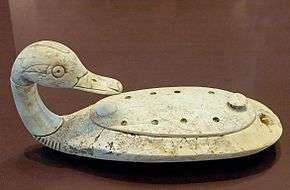Niqmepa
| Ugarit |
|---|
 |
| Places |
| Kings |
| Culture |
Niqmepa (died c. 1270 BC) was the fourth King of Ugarit, a city-state in northwestern Syria. Niqmepa was a contemporary of Mursili II and Hattusili III, the great Hittite kings, as well as Horemheb and Seti I of Egypt.[1] His reign is well documented by cuneiform texts found at Ugarit. He ruled for about fifty years (ca. 1320–1270 BC) making his reign one of the longest in Ugarit history. He was the son of Niqmaddu II, and the brother and successor of Arhalba. Arhalba only ruled for two years and was forced to abdicate in favor of his brother by the Hittite king Mursili II after his failed attempt to reproach Egypt for an alliance against the Hittites.[2]
Niqmepa was installed by the Hittite king Mursili II and was forced to sign a new treaty declaring explicitly that Ugarit was a vassal state of the Hittites.[2] The treaty reveals that Niqmepa had a harem, and states that his woman and children will be held responsible if he fails to honor his obligations.[3] At the same time Ugarit lost control of the territory of Shiyannu to the east, which halved the area controlled by Niqmepa. The secession was confirmed by Mursili II and Shiyannu was placed under the direct control of Carchemish, which was ruled by descendants of Hittite kings as "viceroys". However, because of the loss of Shiyannu, and by request from Niqmepa, the tribute of Ugarit was reduced by a third. During Niqmepa's reign Ugarit became entirely encircled by areas under Hittite control.[2]
Niqmepa married princess Ahatmilku, of the Amurru kingdom to the south.[3] After a long reign of about 50 years as the vassal of four successive Hittite kings, Niqmepa was succeeded by his son, Ammittamru II.[2]
References
- ↑ Sweeney, Emmet John (2007). Empire of Thebes, or, Ages in Chaos Revisited. Algora Publishing. p. 128. ISBN 0-87586-480-5.
- 1 2 3 4 Kuhrt, Amélie (1995). The Ancient Near East, c. 3000-330 BC. Routledge. p. 309. ISBN 0-415-16763-9.
- 1 2 Marsman, Hennie J. (2003). Women in Ugarit and Israel: Their Social and Religious Position in the Context of the Ancient Near East. BRILL. p. 660. ISBN 90-04-11732-6.